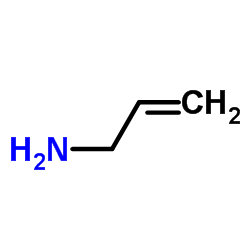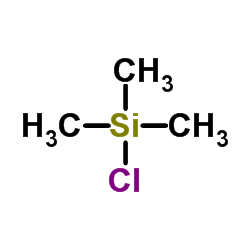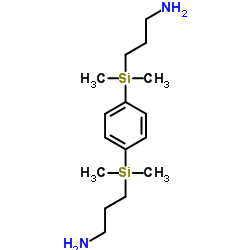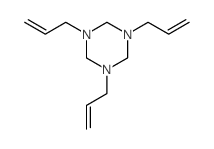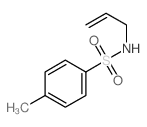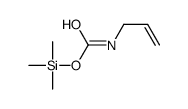10519-97-8
| 中文名 | 1,1,1-三甲基-N-2-丙烯丙胺基硅烷 |
|---|---|
| 英文名 | N-trimethylsilylprop-2-en-1-amine |
| 中文别名 |
烯丙胺基三甲基硅烷
1,1,1-三甲基-N-2-烯丙胺基硅烷 |
| 英文别名 |
N-Allyl-1,1,1-trimethylsilanamine
N-allyl-N-trimethylsilylamine MFCD00053866 Allyl-trimethylsilylamin N-trimethylsilyl allylamine ALLYLAMINOTRIMETHYLSILANE |
| 密度 | 0.8±0.1 g/cm3 |
|---|---|
| 沸点 | 100.5±19.0 °C at 760 mmHg |
| 熔点 | <0ºC |
| 分子式 | C6H15NSi |
| 分子量 | 129.275 |
| 闪点 | 14.6±21.5 °C |
| 精确质量 | 129.097382 |
| PSA | 12.03000 |
| LogP | 1.82 |
| 外观性状 | 透明无色至淡黄色液体 |
| 蒸汽压 | 36.6±0.2 mmHg at 25°C |
| 折射率 | 1.415 |
| 储存条件 | 密闭于阴凉干燥环境中 |
| 稳定性 | 遵照规定使用和储存则不会分解。 |
| 分子结构 | 1、 摩尔折射率:41.88 2、 摩尔体积(m3/mol):167.2 3、 等张比容(90.2K):346.9 4、 表面张力(3.0 dyne/cm):18.5 5、 极化率(0.5 10 -24cm 3):16.60 |
| 计算化学 | 1.疏水参数计算参考值(XlogP):无 2.氢键供体数量:1 3.氢键受体数量:1 4.可旋转化学键数量:3 5.互变异构体数量:无 6.拓扑分子极性表面积12 7.重原子数量:8 8.表面电荷:0 9.复杂度:73.1 10.同位素原子数量:0 11.确定原子立构中心数量:0 12.不确定原子立构中心数量:0 13.确定化学键立构中心数量:0 14.不确定化学键立构中心数量:0 15.共价键单元数量:1 |
| 更多 | 1. 性状:无可用 2. 密度(g/mL,25/4℃):0,77 3. 相对蒸汽密度(g/mL,空气=1):无可用 4. 熔点(ºC):<0 5. 沸点(ºC,常压):110-112 6. 沸点(ºC,5.2kPa):无可用 7. 折射率:1.411-1.416 8. 闪点(ºC):10 9. 比旋光度(º):无可用 10. 自燃点或引燃温度(ºC):无可用 11. 蒸气压(kPa,25ºC):无可用 12. 饱和蒸气压(kPa,60ºC):无可用 13. 燃烧热(KJ/mol):无可用 14. 临界温度(ºC):无可用 15. 临界压力(KPa):无可用 16. 油水(辛醇/水)分配系数的对数值:无可用 17. 爆炸上限(%,V/V):无可用 18. 爆炸下限(%,V/V):无可用 19. 溶解性:无可用 |
Synonym:Allylaminotrimethylsilane Section 2 - COMPOSITION, INFORMATION ON INGREDIENTS
Risk Phrases: 11 34 Section 3 - HAZARDS IDENTIFICATION EMERGENCY OVERVIEW
Highly flammable. Causes burns.Moisture sensitive.Corrosive.Highly flammable. Potential Health Effects Eye: Causes eye burns. May cause conjunctivitis. Contact with the eyes may cause corneal damage. Skin: Causes skin burns. Effects may be delayed. May cause contact dermatitis. May cause cyanosis of the extremities. Ingestion: May cause severe and permanent damage to the digestive tract. Causes gastrointestinal tract burns. May cause perforation of the digestive tract. Ingestion of large amounts may cause CNS depression. May cause systemic effects. Inhalation: Causes chemical burns to the respiratory tract. Inhalation may be fatal as a result of spasm, inflammation, edema of the larynx and bronchi, chemical pneumonitis and pulmonary edema. Vapors may cause dizziness or suffocation. May cause systemic effects. May cause burning sensation, coughing, wheezing, laryngitis, shortness of breath, headache, nausea, and vomiting. May cause burning sensation in the chest. Chronic: Effects may be delayed. Section 4 - FIRST AID MEASURES Eyes: Get medical aid immediately. Do NOT allow victim to rub eyes or keep eyes closed. Extensive irrigation with water is required (at least 30 minutes). Skin: Get medical aid immediately. Immediately flush skin with plenty of water for at least 15 minutes while removing contaminated clothing and shoes. Wash clothing before reuse. Destroy contaminated shoes. Ingestion: Never give anything by mouth to an unconscious person. Get medical aid immediately. Do NOT induce vomiting. If conscious and alert, rinse mouth and drink 2-4 cupfuls of milk or water. Inhalation: Get medical aid immediately. Remove from exposure and move to fresh air immediately. If breathing is difficult, give oxygen. Do NOT use mouth-to-mouth resuscitation. If breathing has ceased apply artificial respiration using oxygen and a suitable mechanical device such as a bag and a mask. Notes to Physician: Treat symptomatically and supportively. Section 5 - FIRE FIGHTING MEASURES General Information: As in any fire, wear a self-contained breathing apparatus in pressure-demand, MSHA/NIOSH (approved or equivalent), and full protective gear. Vapors may form an explosive mixture with air. Vapors can travel to a source of ignition and flash back. During a fire, irritating and highly toxic gases may be generated by thermal decomposition or combustion. Use water spray to keep fire-exposed containers cool. Water may be ineffective. Material is lighter than water and a fire may be spread by the use of water. Flammable liquid and vapor. Vapors may be heavier than air. They can spread along the ground and collect in low or confined areas. Will be easily ignited by heat, sparks or flame. Containers may explode if exposed to fire. Runoff from fire control or dilution water may cause pollution. Extinguishing Media: Use foam, dry chemical, or carbon dioxide. Water may be ineffective. Water may spread fire. If water is the only media available, use in flooding amounts. Do NOT get water inside containers. Do NOT use straight streams of water. Cool containers with flooding quantities of water until well after fire is out. Section 6 - ACCIDENTAL RELEASE MEASURES General Information: Use proper personal protective equipment as indicated in Section 8. Spills/Leaks: Absorb spill with inert material (e.g. vermiculite, sand or earth), then place in suitable container. Avoid runoff into storm sewers and ditches which lead to waterways. Clean up spills immediately, observing precautions in the Protective Equipment section. Remove all sources of ignition. Use a spark-proof tool. Provide ventilation. Do not get water inside containers. A vapor suppressing foam may be used to reduce vapors. Section 7 - HANDLING and STORAGE Handling: Ground and bond containers when transferring material. Use spark-proof tools and explosion proof equipment. Do not breathe dust, vapor, mist, or gas. Do not get in eyes, on skin, or on clothing. Empty containers retain product residue, (liquid and/or vapor), and can be dangerous. Keep container tightly closed. Keep away from heat, sparks and flame. Do not ingest or inhale. Do not allow contact with water. Use only in a chemical fume hood. Discard contaminated shoes. Do not pressurize, cut, weld, braze, solder, drill, grind, or expose empty containers to heat, sparks or open flames. Keep from contact with moist air and steam. Storage: Keep away from sources of ignition. Store in a cool, dry place. Keep container closed when not in use. Store in a tightly closed container. Flammables-area. Store protected from moisture. Store under nitrogen. Section 8 - EXPOSURE CONTROLS, PERSONAL PROTECTION Engineering Controls: Facilities storing or utilizing this material should be equipped with an eyewash facility and a safety shower. Use adequate general or local explosion-proof ventilation to keep airborne levels to acceptable levels. Exposure Limits CAS# 10519-97-8: Personal Protective Equipment Eyes: Wear appropriate protective eyeglasses or chemical safety goggles as described by OSHA's eye and face protection regulations in 29 CFR 1910.133 or European Standard EN166. Skin: Wear appropriate protective gloves to prevent skin exposure. Clothing: Wear appropriate protective clothing to prevent skin exposure. Respirators: Follow the OSHA respirator regulations found in 29 CFR 1910.134 or European Standard EN 149. Use a NIOSH/MSHA or European Standard EN 149 approved respirator if exposure limits are exceeded or if irritation or other symptoms are experienced. Section 9 - PHYSICAL AND CHEMICAL PROPERTIES Physical State: Liquid Color: straw-colored - amber Odor: Not available. pH: Not available. Vapor Pressure: Not available. Viscosity: Not available. Boiling Point: 110 - 112 deg C Freezing/Melting Point: Not available. Autoignition Temperature: Not available. Flash Point: 10 deg C ( 50.00 deg F) Explosion Limits, lower: Not available. Explosion Limits, upper: Not available. Decomposition Temperature: Solubility in water: Reacts. Specific Gravity/Density: Molecular Formula: C6H15NSi Molecular Weight: 129.28 Section 10 - STABILITY AND REACTIVITY Chemical Stability: Moisture sensitive. Conditions to Avoid: Ignition sources, excess heat, exposure to moist air or water. Incompatibilities with Other Materials: Oxidizing agents. Hazardous Decomposition Products: Nitrogen oxides, carbon monoxide, carbon dioxide, silicon dioxide. Hazardous Polymerization: Has not been reported Section 11 - TOXICOLOGICAL INFORMATION RTECS#: CAS# 10519-97-8 unlisted. LD50/LC50: Not available. Carcinogenicity: N-(Trimethylsilyl)Allylamine - Not listed by ACGIH, IARC, or NTP. Section 12 - ECOLOGICAL INFORMATION Ecotoxicity: Fish: Pseudomonas putida: Section 13 - DISPOSAL CONSIDERATIONS Dispose of in a manner consistent with federal, state, and local regulations. Section 14 - TRANSPORT INFORMATION IATA Not regulated as a hazardous material. IMO Not regulated as a hazardous material. RID/ADR Not regulated as a hazardous material. Section 15 - REGULATORY INFORMATION European/International Regulations European Labeling in Accordance with EC Directives Hazard Symbols: F C Risk Phrases: R 11 Highly flammable. R 34 Causes burns. Safety Phrases: S 9 Keep container in a well-ventilated place. S 16 Keep away from sources of ignition - No smoking. S 25 Avoid contact with eyes. S 33 Take precautionary measures against static discharges. S 36/37/39 Wear suitable protective clothing, gloves and eye/face protection. S 45 In case of accident or if you feel unwell, seek medical advice immediately (show the label where possible). WGK (Water Danger/Protection) CAS# 10519-97-8: No information available. Canada None of the chemicals in this product are listed on the DSL/NDSL list. CAS# 10519-97-8 is not listed on Canada's Ingredient Disclosure List. US FEDERAL TSCA CAS# 10519-97-8 is not listed on the TSCA inventory. It is for research and development use only. SECTION 16 - ADDITIONAL INFORMATION N/A |
|
生态学数据: 该物质对环境可能有危害,对水体应给予特别注意。
|
| 危害码 (欧洲) | C: Corrosive; |
|---|---|
| 风险声明 (欧洲) | R34 |
| 安全声明 (欧洲) | 45-36/37/39-25-16-26-23 |
| 危险品运输编码 | UN 2924 |
| 海关编码 | 2931900090 |
|
~94% 
10519-97-8 |
| 文献:WO2008/115190 A1, ; Page/Page column 16-17 ; |
|
~94% 
10519-97-8 |
| 文献:J. Gen. Chem. USSR (Engl. Transl.), , vol. 54, # 2 p. 367 - 371,327 - 331 |
| 上游产品 3 | |
|---|---|
| 下游产品 8 | |
| 海关编码 | 2931900090 |
|---|---|
| 中文概述 | 2931900090. 其他有机-无机化合物. 增值税率:17.0%. 退税率:13.0%. 监管条件:AB(入境货物通关单,出境货物通关单). 最惠国关税:6.5%. 普通关税:30.0% |
| Summary | 2931900090. other organo-inorganic compounds. VAT:17.0%. Tax rebate rate:13.0%. Supervision conditions:AB(certificate of inspection for goods inward,certificate of inspection for goods outward). MFN tariff:6.5%. General tariff:30.0% |


